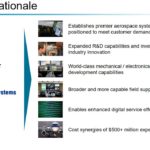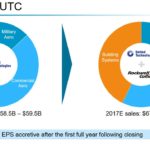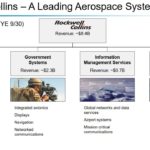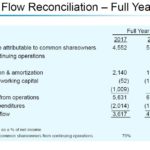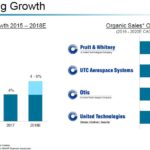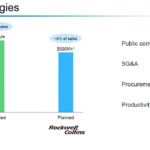Contents

Summary
- Rockwell Collins recently approved its $30B takeover by United Technologies. The transaction is expected to close later in 2018.
- The acquisition is a shrewd move although United Technologies appears to be paying slightly more than full price.
- The recently introduced US tax changes will enable United Technologies to repatriate funds held overseas which will allow it to start reducing debt more quickly and allow it to repurchase outstanding shares this year as opposed to waiting several years as originally planned.
- I view United Technologies as fully valued subsequent to the recent run up in price and will wait for a pullback before adding to my existing position.
United Technologies (NYSE: UTX) is a member of the FFJ Master Stock List. Shares are not held in the FFJ Portfolio but rather in undisclosed accounts. The majority of these UTX shares were acquired April 18, 2008 and all subsequently received dividends have been automatically reinvested.
Introduction
UTX reported Q4 and FY2017 results on January 24, 2018. In addition, Rockwell Collins (NYSE: COL) shareholders overwhelmingly approved the sale to UTX; a definitive agreement had been reached in early September 2017 under which UTX will acquire COL for $140.00/share in cash and UTX stock.
The proposed $30B acquisition of COL, an avionics and cabin interiors supplier, will enable UTX to broaden its aerospace portfolio which is currently highly dependent on the geared turbofan engine.
Source: UTX Acquisition of COL presentation – September 5, 2017
Business Overview
UTX is organized into the following 4 segments (Otis, UTX Climate Controls and Security, Pratt & Whitney, and UTX Aerospace Systems). Details on each segment can be accessed here.
Pending regulatory approval, COL and UTX Aerospace Systems will be amalgamated to form a new business segment named Collins Aerospace Systems; the merger is expected to close in Q3 2018.
Through the sale of Sikorsky in 2015, UTX streamlined its aerospace business. This sale reduced the company’s exposure to a difficult military helicopter market and enabled it to increase its focus on a portfolio of components and systems in which 70% of sales is derived from a growing commercial aerospace market.
Each of UTX’s 4 segments manufactures highly engineered equipment. The company allocates ~4% of consolidated sales to research and development. In addition, customer-funded research and development is typically in the range of 3%-4% of UTX’s annual sales.
UTX’s track record on product innovation and the durability and reliability of its products allows it to differentiate itself from the competition.
The development of a new aircraft engine, for example, can take the better part of 20 years.
UTX benefits from a high degree of customer switching costs.
In fiscal 2014, 2015, and 2016, for example, UTX derived 44%, 44%, and 46% of its consolidated net sales from aftermarket parts and services. The remainder of its sales were derived from original equipment manufacturing (OEM).
Rockwell Collins (COL)
COL was founded as Collins Radio in 1933. It initially designed and produced short wave radio equipment. It grabbed the world’s attention when it supplied the equipment to establish a communications link with the South Pole expedition of Rear Admiral Richard Byrd in 1933.
Over the next three decades, COL broadened its technology to include flight control instruments, radio communication devices and satellite voice transmissions. It provided communications in the US space program which included equipment for astronauts to communicate with earth stations and equipment to track and communicate with spacecraft. Its communications equipment was used for the Apollo, Gemini and Mercury programs. In 1973, the U.S. Skylab Program used COL equipment to provide communication from the astronauts to earth.
The company encountered financial difficulties in 1973 and was acquired by Rockwell International, a diversified high-technology company. Over the years, Rockwell International made a series of acquisitions and was organized into 9 major divisions (Space, Aircraft, Defense Electronics, Commercial Electronics, Light Duty Automotive Components, Heavy Duty Automotive Components, Printing Presses, Valves and Meters, and Industrial Automation)
The completion of the Space Shuttle program and the completion of the B-1 bomber program, however, led to a decline in revenues. In an effort to turn around the company, Rockwell International diversified away from government contracts.
On June 29, 2001, Rockwell Collins, Inc. was spun-off from Rockwell International and began trading on the NYSE.
The COL of today designs, produces, markets, and supports electronic communications, avionics and in-flight entertainment systems for commercial, military and government customers worldwide. Its aircraft electronics are installed in the cockpits of nearly every airline in the world and its communication systems transmit nearly 70% of U.S. and allied military airborne communications.
In the fiscal years ending September 30, 2013 – 2017, COL generated revenue of $6.352B, $6.624B, $6.308B, $5.88B, and $6.311B.
The following provides more color as to the rationale for the proposed acquisition and UTX management expectations subsequent to the acquisition.
Source: UTX Acquisition of COL presentation – September 5, 2017
Q4 and FY2017 Financial Results
UTX Q4 and FY2017 results can be found here.
UTX experienced its best year of organic growth since 2014 at 4% with each of the 4 business units experiencing organic growth; Pratt & Whitney topped the group at 9%.
Full year free cash flow (FCF) exceeded $3.6B after substantial strategic investments and the full funding of the U.S. domestic pension plan.
You are encouraged to review UTX’s January 24, 2018 Q4 and FY2017 Results and 2018 Outlook presentation for more details.
Forecast
The following forecast for 2018 adjusted earnings per share (EPS) was provided January 24, 2018 and excludes COL.
Source: UTX’s January 24, 2018 Q4 and FY2017 Results and 2018 Outlook presentation
As in prior years, Q1 2018 EPS are expected to be flat relative to 2017 earnings. EPS growth is expected to be weighted more toward the second half of FY2018 by which time UTX should begin to benefit from its cost reduction efforts.
UTX has indicated that it will maintain its focus on growth through innovation and will continue to focus on cost reduction and in being disciplined in its allocation of capital.
Organic sales are expected to accelerate for the fourth straight year with growth ranging between 4% - 6%; sales in the range of $62.5B - $64B (excludes COL) are projected.
Source: UTX’s January 24, 2018 Q4 and FY2017 Results and 2018 Outlook presentation
In addition, FCF in the range of $4.5B - $5B is expected even as it invests over $4B in capital expenditures (CAPEX).
UTX is of the opinion the global macroeconomic environment is expected to remain robust in 2018. It anticipates modest acceleration with growth above 2.5% in the US and notes that conditions in Western Europe have been improving as evidenced by what it sees in its order rates.
China reported strong Q4 GDP and is expected to grow above 6% again in 2018 but construction-related end markets in China for UTX will remain under price pressure, although an improvement from 2016 and 2017 conditions is expected.
The new tax changes are expected to lower UTX’s effective tax rate to 25.5% versus the 27.8% in 2017. This new level is based on the fact that ~60% of UTX’s earnings are generated overseas.
The U.S. federal tax rate was at 35% and UTX’s blended global rate was about 30%. It used to receive a couple of points of credits that reduced the effective tax rate to ~28%.
Under the new tax rules, the credits will be eliminated meaning UTX will be starting from a 30% blended tax rate. The benefit from recent U.S. tax law changes is a federal rate reduction of 14% (35% to 21%) on 40% of earnings generated within the US.
This means the new tax rate should be 24.5%. There are, however, some provisions that add another point which results in the 25.5% tax rate previously referenced.
Furthermore, the tax law changes will result in a net ~$1.5B cumulative cash payment on previously earned foreign income which will be paid through 2026.
Long-Term Credit Rating
In September 2015, the external rating agencies downgraded UTX’s debt ratings (“A” to “A-”, and “A2” to “A3”) with a stable ratings outlook; these ratings are at the low end of the upper medium grade tier. These downgrades were primarily attributed to the level of UTX’s completed and projected share repurchase activity.
The ratings agencies currently have these ratings under review as a result of the $14B - $15B UTX will need to borrow to complete the COL acquisition.
UTX has roughly $8B in cash held overseas and approximately two-thirds of its earnings come from abroad. It typically repatriates about $1B annually in overseas funds but under the new tax law it will, as previously noted, now incur a 21% versus a 35% corporate tax rate. Under the new tax law, UTX will be able to repatriate about $3B in funds held overseas which will enable it to repay the debt raised for the COL acquisition more quickly; the original intent was to repay ~$1B of the COL debt in 2018.
In addition to repaying its debt more quickly, the additional funds from the tax policy will enable UTX to also begin share repurchases this year as opposed to waiting another 4 -5 years as originally planned.
Valuation
Adjusted diluted EPS amounted to $6.65 in FY2017. Using the January 26, 2018 closing share price of $137.98 we arrive at an adjusted PE of ~20.75%.
Management has forecast adjusted EPS of $6.85 - $7.10 for FY2018 thus giving us a forward adjusted PE range of ~19.43 - ~20.14.
I view the COL acquisition as a smart move on UTX’s part since I perceive the commercial aerospace industry to be in an up cycle. My concern, however, is that UTX is paying up for COL. In addition, UTX’s share count will increase as the $30B purchase price will be financed with ~$14B - $15B in debt, the assumption of COL’s ~$7B in debt, and the issuance of ~65 million shares. This represents a ~8% increase to UTX’s current 799.1 million shares outstanding.
While I don’t think UTX has significantly overpaid for COL, I am of the opinion it will need to ensure it finds the $0.5B of annual cost synergies it has projected.
Source: UTX Acquisition of COL Presentation – September 5, 2017
Given the above, I think UTX is slightly overvalued at current levels.
While UTX’s dividend history reported here only goes back to 1980, UTX has paid cash dividends on its common stock every year since 1936.
The current $0.70/quarter ($2.80/year) dividend was increased in Q3 2017. Based on the January 26, 2018 $137.98 closing stock price, UTX has a ~2% dividend yield.
While UTX has a 9.375% compound annual dividend growth rate for the 2006 – 2017 period, the dividend increases in FY2016 and FY2017 are well below those during the 2006 – 2015 period.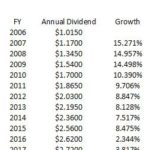
The outlook for 2018’s adjusted EPS, which excludes COL, is $6.85 - $7.10/share. On this basis, UTX’s dividend payout ratio will be in the ~39.4% - ~40.8% range.
UTX has rewarded shareholders with share repurchases in recent years. In 2013, there were ~915.1 million shares outstanding. As at December 31, 2017 there were ~799 million shares outstanding. As previously noted, the recent changes to UTX’s tax rate will enable UTX to begin share repurchases this year.
Final Thoughts
I view the acquisition of COL by UTX as a smart move. My concern is that UTX’s shares are fully valued; UTX’s shares have experienced a significant run up in recent months which I attribute in part to ‘the fear of missing out’.
I certainly view UTX is a high quality company but I am of the opinion that it would be best to wait for UTX to retrace to a lower level ($130 or below) before adding to my existing position.
Thanks for reading!
Note: Thanks for reading this article. Please send any feedback, corrections, or questions to [email protected].
Disclaimer: I have no knowledge of your individual circumstances and am not providing individualized advice or recommendations. I encourage you not to make any investment decision without conducting your own research and due diligence, and consulting your financial advisor about your specific situation.
Disclosure: I am long UTX.
I wrote this article myself and it expresses my own opinions. I am not receiving compensation for it and have no business relationship with any company whose stock is mentioned in this article.


